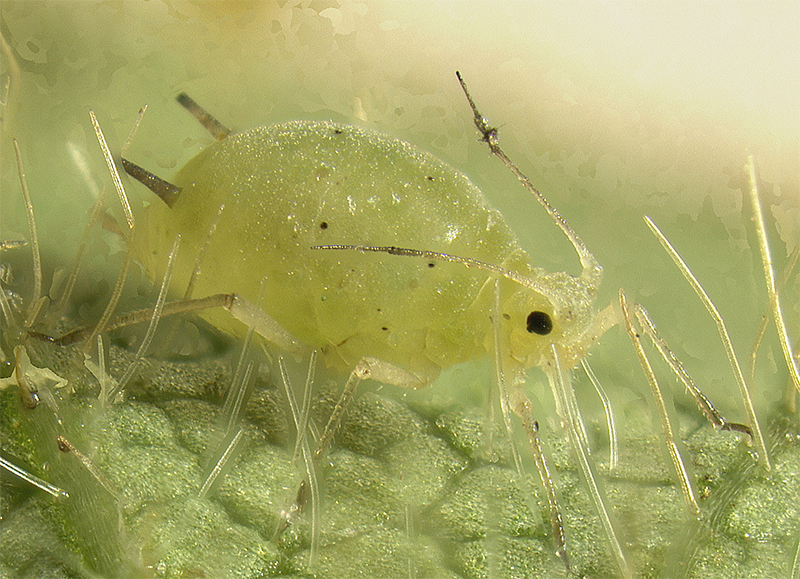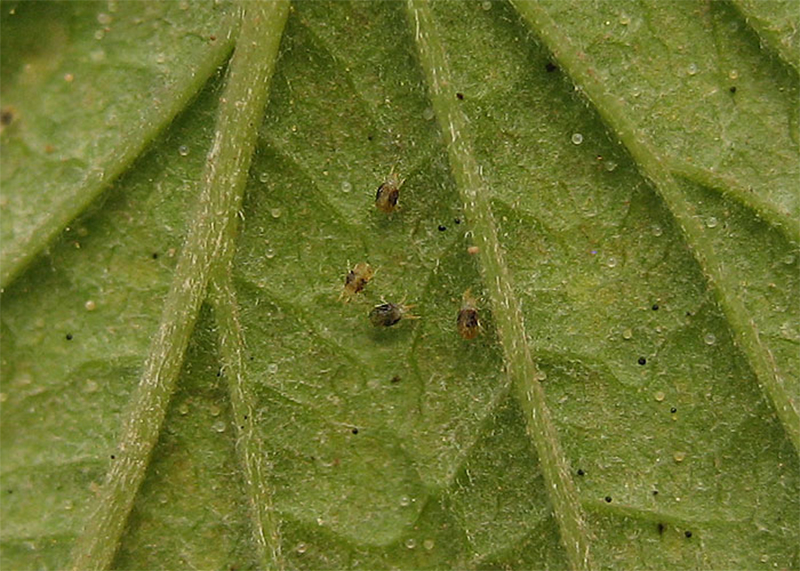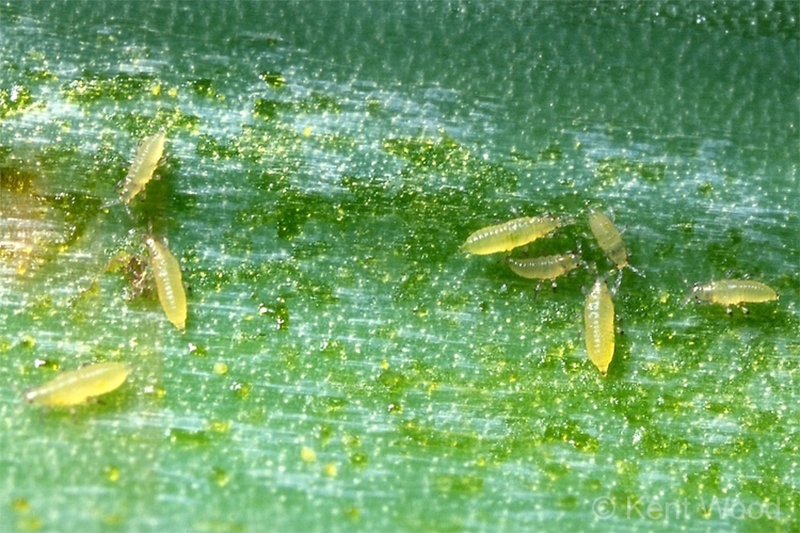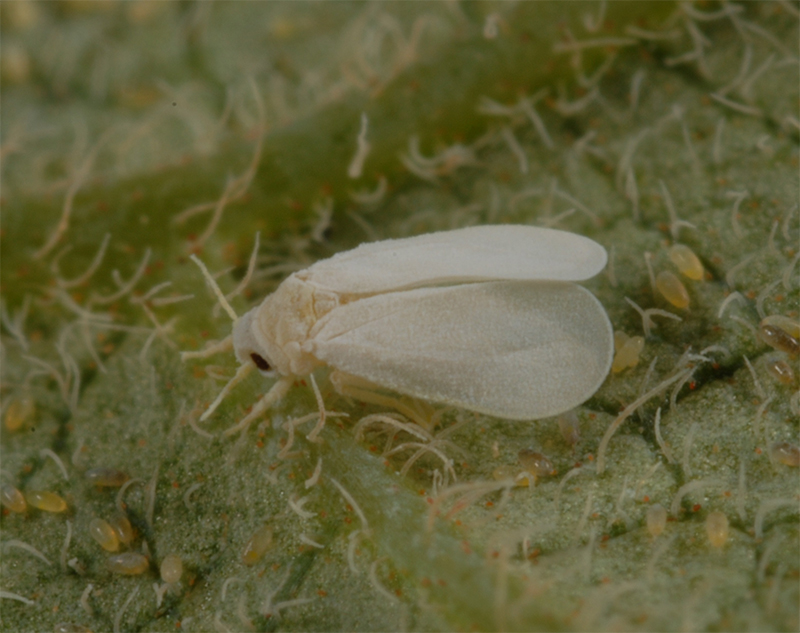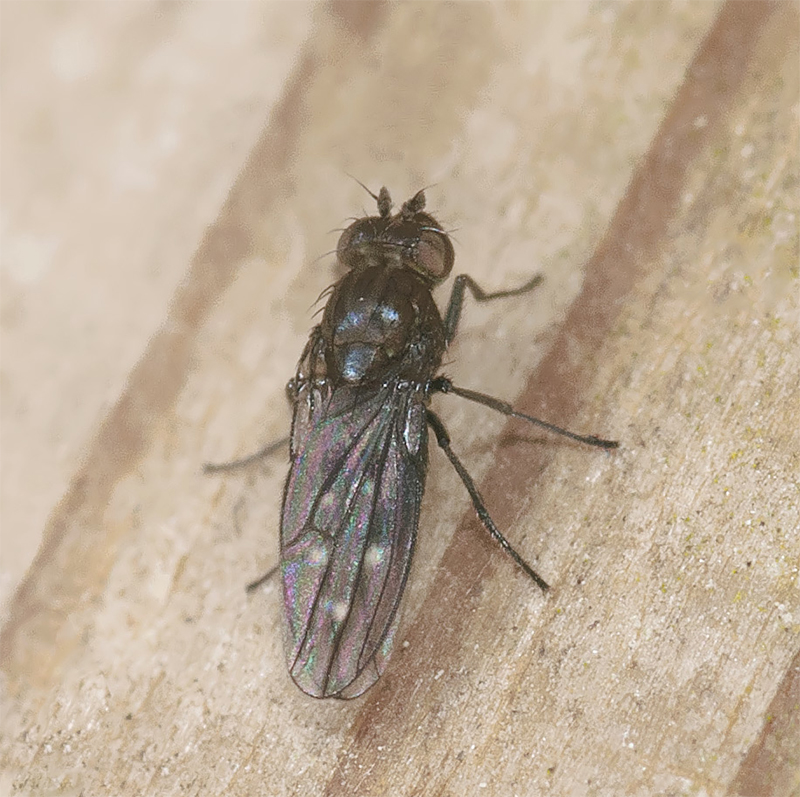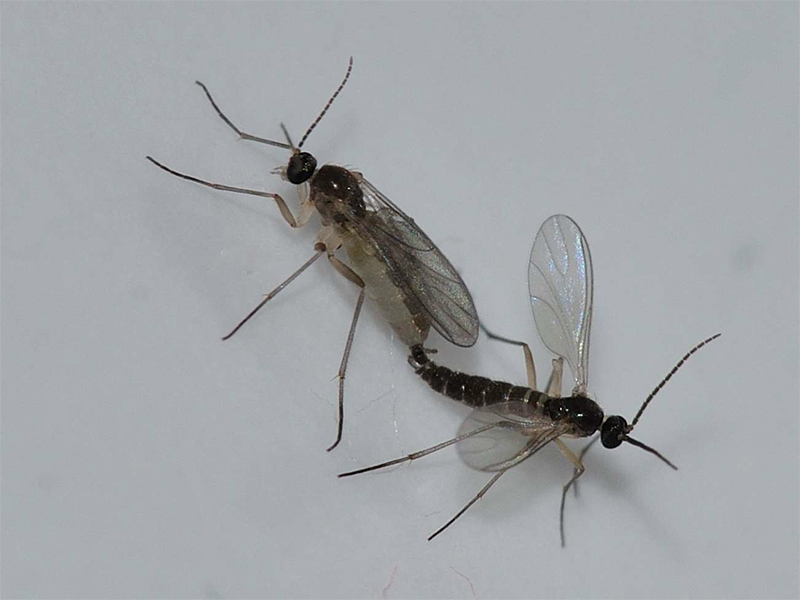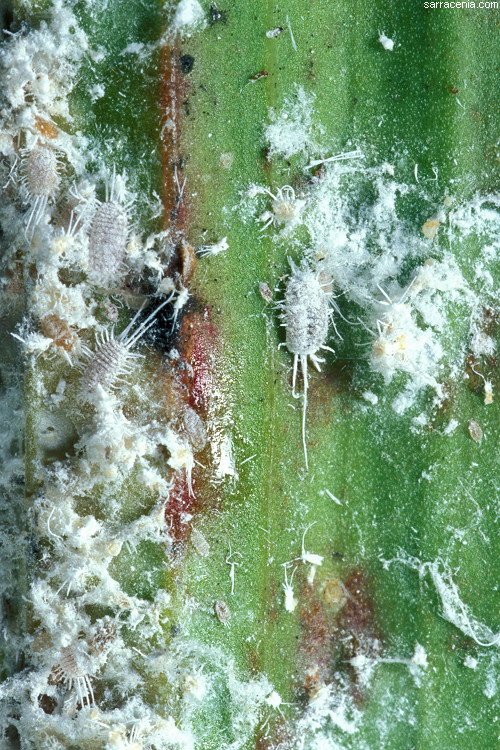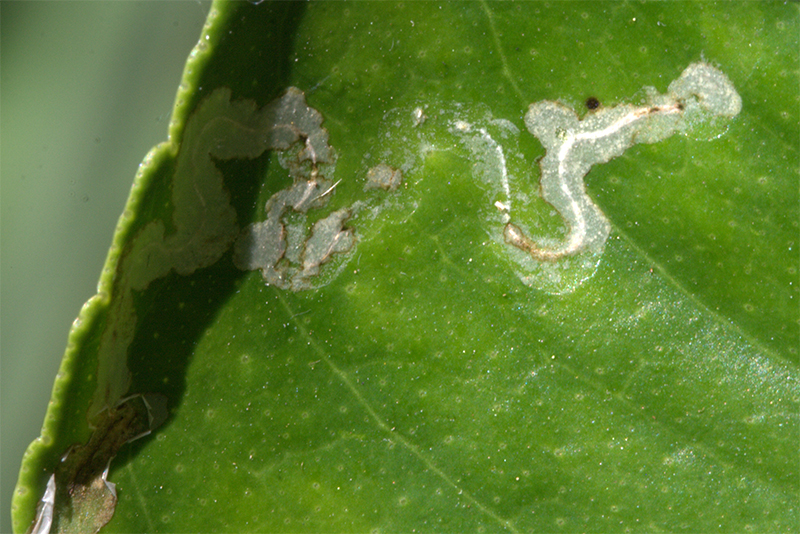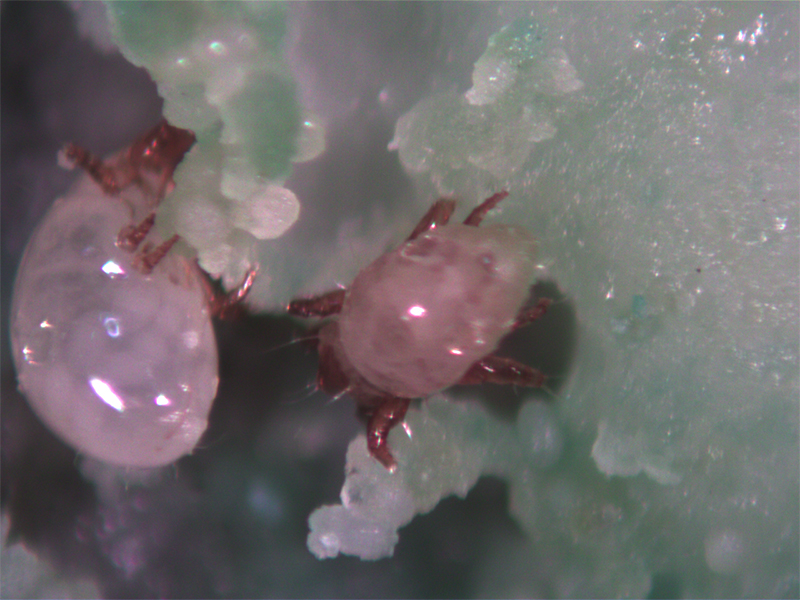Bio Controls for Crop Pest Management
By Brandon Pillon
There are many beneficial organisms that can be used in a greenhouse or grow room to reduce pest populations without the use of chemical pesticides.
Bio Control Methods
For biological control methods to be effective they must be used with other methods, such as exclusion and sanitation. A low level pest population must be present for a successful biological control program. Living organisms that can be used to reduce populations include predators, parasites, and pathogens. A predator is typically an insect or insect related animal that attacks or feeds on a pest. This attack is typically part of the predator’s natural feeding cycle. Some predators also feed on pollen, nectar, and honeydew. Many feed on prey that is abundant including a variety of insects and mites as well as other pests. Typical examples of predators include ladybugs and predatory mites to name a few. A parasite is an organism that attacks and kills a pest host by injecting and laying eggs inside of the pest. Typically the parasite completes all or part of its life cycle in or on the pest; many parasites feed on the host in their immature stage and live “free” as an adult to begin the cycle over again. A parasite by the name of Encarsia formosa is an example of a parasite that injects its eggs into an immature stage of a whitefly; the parasite nymph then consumes the whitefly from the inside. Another example is a parasitic nematode named Steinernema feltiae; this nematode enters an insect larva and develops within the larva, eventually killing the pest. A pathogen is typically a microorganism that brings about disease on a pest insect host. Bacillus thuringiensis is a good example of a bacterial organism that infects worm larvae. Beauveria bassiana is an example of fungal organism that infects the exoskeleton of many insect pests.
Pests and Biological Control Methods
Aphids
Aphids can become a real plague on crops in a very short period of time. Aphids extract nutrients from the plant, which affects plant growth. Aphids secrete honeydew which fouls leaves and fruit making the plant and fruit unmarketable. Aphids can also transmit viruses and inject toxic substances into the plant that causes malformations and crop disease(s) because they pierce and suck and move from plant to plant. The most widespread species of aphids are green peach aphid (Myzus persicae), cotton aphid (Aphis gossypii), potato aphid (Macrosiphum euphorbiae) and foxglove aphid (Aulacorthum solani).
Biological Control Methods for Aphids
Aphelinus Abdominalis – is a parasitic wasp of large aphid species such as potato and foxglove aphids. An aphid parasitized by Aphelinus is transformed into a black mummy. Advantages of Aphelinus are its high number of offspring, its longevity and its sustained activity at high temperatures.
Aphidius Colemani – is a parasitic wasp of small aphid species such as green peach and cotton aphids. A parasitized aphid swells and becomes a golden-brown and leathery mummy. Aphidius colemani is a very good flyer and is able to locate small colonies or even individual aphid.
Aphidius Ervi – a parasitic wasp similar in shape but twice as large as Aphidius colemani. It is used against large aphid species such as potato and foxglove aphids. An aphid parasitized by Aphidius ervi turns into a gold-yellowish-brown mummy.
Aphidoletes Aphidimyza – is a predatory gall midge of many aphid species. It is mostly active at night and can multiply quickly in a short period of time. Female Aphidoletes fly to locate aphid colonies and deposit clusters of eggs in these colonies. After hatching, Aphidoletes larvae will immediately start feeding on aphids. Aphidoletes is used against heavy infestation of aphids.
Chrysopa spp. – are predatory lacewings of many aphid species. Only the larval stages feed on aphids. Chrysopa can be used in vegetable, fruit and ornamental crops, and perform very well in crops where large temperature and relative humidity fluctuations occur. Chrysopa can also eat thrips, spider mites, whitefly, small caterpillars, and mealybugs. Adalia bipunctata Adalia bipunctata is a predatory beetle (ladybug) of aphids. Larval and adult stages of Adalia eat many aphid species. This beetle is well suited to be used against heavy infestations of aphids in ornamental, fruit and vegetable crops.
Spider Mites
Spider mites are not insects but arachnids. The most common spider mite in vegetable, ornamental and small fruit crops is the two-spotted spider mite (Tetranychus urticae). Spider mites suck plant sap for food; feeding damage shows as small yellow spots on the leaf upper surface. This reduces photosynthetic area, weakens the plant and decreases yield. Also, webs made by mites reduce the aesthetic value of ornamentals. Other mites commonly found on crops are the carmine spider mite (Tetranychus cinnabarinus), broad mite (Polyphagotarsonemus latus) and cyclamen mite (Tarsonemus pallidus).
Biological Control Methods for Spider Mites
Phytoseiulus Persimilis – is a very efficient predatory mite of the two-spotted spider mite. It has a voracious appetite, and can completely wipe out a spider mite colony. When plants touch each other, Phytoseiulus can spread relatively easily throughout a crop though nymphs tend to stay in the same place. Phytoseiulus activity is slowed down by high temperature or low humidity.
Feltiella Acarisuga – is a predatory gall midge o the two-spotted spider mite and carmine spider mite. Female Feltiella deposit their eggs in spider mite colonies. Immediately after hatching larvae start devouring spider mites. After introduction, Feltiella will be concentrated in large mite colonies, but will distribute to smaller colonies as its population increases. Adult Feltiella are excellent flyers and easily spread across the whole crop.
Amblyseius Californicus – is another predatory mite of spider mites; it is a valuable aid to Phytoseiulus. Amblyseius also eats pollen; because of this it can be released preventively even before spider mites appear in the crop. Amblyseius californicus is more tolerant of high temperatures and low humidity, and it can also eat broad mites and cyclamen mites.
Thrips
The most common thrips species are the western flower thrips (Frankliniella occidentalis) and the onion thrips (Thrips tabaci). Thrips damage plants by piercing plant cells and emptying their contents. Damage is visible as silver-grey spots with dark dots (thrips excrement). Thrips can also attack flowers, which may result in flower or fruit deformities. Thrips are also spread viruses such as the tomato spotted wilt virus.
Biological Control Methods for Thrips
Amblyseius Cucumeris – is a small predatory mite of thrips. It is effective on vegetables such as sweet pepper, cucumber, eggplant and some ornamentals. Amblyseius cucumeris also feeds on pollen, so it can be used preventively in pollen bearing crops. Amblyseius cucumeris should be aided by other thrips enemies like Orius insidiosus and Amblyseius degenerans.
Amblyseius Swirskii – is a small predatory mite that feeds on thrips. It looks Amblyseius cucumeris and has many of its characteristics; it feeds on pollen, which allows it to be used preventively in pollen bearing crops. The main advantage of A. swirskii over A. cucumeris is that it is also a good predator of whitefly eggs and larvae and that they perform better at high temperatures. They also eat some pest mites but these pests are secondary targets.
Amblyseius Degenerans – is another predatory mite of thrips; it is more mobile, has a faster population growth, is less sensitive to low humidity and controls thrips better in flowers than A. cucumeris. Amblyseius degenerans can feed on pollen; so it can be introduced preventively in pollen bearing crops. It should be introduced early in the season to allow the population to build up.
Orius Insidiosus (Ed Note-THIS is one Bad Ass insect!) – is a highly mobile thrips predator. Since Orius is a long-lived bug, and takes time to reproduce and become established, it is important to introduce Orius as early as possible. Orius also feeds on pollen, so it can be introduced preventively in pollen bearing crops. It also feeds on other pests, such as whiteflies, aphids, red mites and moth eggs.
Whitefly
In greenhouse horticulture, the greenhouse whitefly (Trialeurodes vaporariorum) is a very common pest. However the tobacco whitefly (Bemisia tabaci) is increasingly becoming a serious problem in many crops. This species is more difficult to control than the common greenhouse whitefly. Whitefly larvae ingest large amounts of plant sap; they then secrete honeydew, which fouls leaves and fruit making them unmarketable. Mould then starts to grow on the honeydew and this can lead to serious problems for the crop. Whiteflies can also transmit several viruses.
Biological Control Methods for Whitefly
Encarsia Formosa – is a small wasp that lays eggs inside greenhouse whitefly larvae. Parasitized whitefly pupae turn black, which makes it easy to check Encarsia’s activity. Instead of whiteflies, adult Encarsia emerge from the black pupae. Encarsia also kill young whitefly larvae by feeding on them.
Eretmocerus Eremicus – is a small wasp that parasitizes and host feeds on both greenhouse whitefly and tobacco whitefly larvae. Eretmocerus eremicus is a valuable tool for whitefly control, because it has specific advantages over Encarsia, being that it is more tolerant of higher temperatures and pesticide residues.
Eretmocerus Mundus – is a parasitic wasp, specifically for the control of tobacco whitefly. Eretmocerus mundus is extremely well adapted to varying climatic conditions, and is more active at higher and lower temperatures than E. eremicus. Therefore, E. mundus can be introduced at any time during the season, and is perfectly suited for early season introductions. Eretmocerus mundus also has better tolerance to chemical pesticide residues. Amblyseius swirskii Amblyseius swirskii is a small predatory mite that feeds on both whitefly eggs and larvae as well as on thrips larvae. A. swirskii performs best when it can feed on both whitefly and thrips. A. swirskii also feeds on pollen and therefore can be used preventively in pollen bearing crops.
Scatella
Scatella (shore fly) adults are tiny black flies with clear spots on their wings. They feed on unicellular organisms like algae and bacteria. Although Scatella do not cause direct damage to plants, they are a nuisance that can decrease the marketability of finished products; their fast reproduction results in clouds of adults on plants and their excrement lowers the aesthetic value of plants. Biological Control Methods for Scatella Atheta coriaria is a predatory rove beetle of soil dwelling insects. It is highly effective against Scatella (shore fly) and sciarids (fungus gnats). Atheta can be used in almost any type of growing media like rockwool, coco coir, sawdust and soil. Adult and larval stages are predatory and highly mobile. Adults can fly so only a few introduction points are needed in a greenhouse. Sciaridae (Fungus Gnats)
Adults are harmless, but larvae chew roots
Sciarid (fungus gnat) adults are small black flies with long, slender antennae and long legs. Damage to plants is caused by the long and translucent white larva, which has a distinctive black head. Larvae feed on dead material in the growing media and also on living material such as roots and stalk tissue. Damage plant tissues are then susceptible to plant diseases such as Pythium, Phytophthora, Botrytis, Fusarium, and Verticillium. General symptoms of sciarid damage are reduced growth and wilting of plants; in the worst case, plants may die. Biological Control Methods for Sciaridae Hypoaspis miles Hypoaspis miles is a small predatory mite that inhabits the top layer of soil and feeds on sciarid larvae. Hypoaspis is most effective when used preventively, and can be also used either alone or in combination with the nematode Steinernema feltiae. Hypoaspis can also feed on thrips pupae, millipedes, and root aphids. It can survive up to seven weeks without food. Steinernema feltiae Steinernema feltiae is a parasitic nematode of sciarid larvae. This nematode actively seeks out sciarid larvae to infect; once inside, it releases symbiotic bacteria, which eventually kills the sciarid larva. The nematode reproduces inside the larva. When the sciarid larva decomposes, a new generation of nematodes is released and moves off in search of new prey. Mealybug
Tough to kill with pesticides
Mealybugs are one of the hardest pests to control. The mealybugs body is covered with white waxy threads, which protects it from pesticides. The most common mealybug is the citrus mealybug (Planococcus citri), which attacks many ornamental crops, cucumber, melon and eggplant. Mealybugs feed on plant sap, which cause leaf yellowing and wilting, and reduces plant vigour and growth. Mealybugs secrete honeydew, on which fungi can grow. Biological Control Methods for Mealybug Cryptolaemus montrouzieri Cryptolaemus montrouzieri is a predatory beetle (ladybug) of mealybugs. Adults and larvae eat every stage of many mealybug species. Cryptolaemus is very effective against high infestations and can be used in combination with the citrus mealybug parasite Leptomastix dactylopii. Leptomastix dactylopii Leptomastix dactylopii is a parasitic wasp of the citrus mealybug. Female Leptomastix lay their eggs inside mealybugs. After hatching, a Leptomastix larva feeds on a mealybug and consequently kills it. A parasitized mealybug swells and becomes darker in colour. Leafminer
Miner insect that can do major damage
Leafminers (Liriomyza spp.) are dipterous insects, just like the common housefly. Leafminer larvae eat their way inside the leaf tissue, thus creating mines. The mines reduce the photosynthetic area, weaken the plant, decrease yield and reduce the aesthetic value of ornamentals. Leaves may also dry out. Adult female leafminers cause damage by piercing the leaf surface to feed on plant sap. Biological Control Methods for Leafminer Dacnusa sibirica Dacnusa sibirica is a small wasp that lays its eggs inside leafminer larvae. A parasitized leafminer larva does not immediately stop feeding, but will eventually be killed by the developing Dacnusa larva. Finally, an adult Dacnusa will emerge from the leafminer, and start looking for new leafminers to parasitize. Dacnusa is very effective when leafminer populations are low; making it a perfect candidate to use early in the season, or in crops where tolerance for leafminer damage is low. Diglyphus isaea Diglyphus isaea is another parasitic wasp of leafminer. However, unlike Dacnusa, Diglyphus first paralyses the leafminer larva and then lays an egg beside the larva. Adult female Diglyphus also feed on leafminers. Diglyphus is the most effective when leafminer populations are high. Bulb Mite
A Dutchman’s nightmare!
Bulb mites (Rhizoglyphus robini) are a serious problem for the bulb industry. They can cause a lot of damage either during bulb multiplication or bulb production. While eating, the mite makes little holes in the bulb, which cause malformation and inhibit growth. Damaged bulbs are more susceptible to bacterial and fungal diseases. Biological Control Methods for Bulb Mite Hypoaspis aculeifer Hypoaspis aculeifer is a predatory mite of bulb mites. It can be used as a preventive measure. If bulb mites are absent, H. aculeifer can feed on other soil insects, and can also survive without food for up to seven weeks. Black Vine Weevil The adult black vine weevil (Otiorhynchus sulcatus) feeds on the edges of leaves and flowers. However, it is the larvae that cause the most damage. Newly emerged larvae feed on small roots; as larvae grow, they feed on larger roots, tubers, and can even strip the bark from woody stems. Damage can cause plants to wilt and even die. Biological Control Methods for Black Vine Weevil Heterorhabditis megidis Heterorhabditis megidis is a nematode that seeks out black vine weevil larvae present in the root zone. The nematode enters a weevil larva and releases symbiotic bacteria that kills the larva. The nematode reproduces inside the weevil larva. An infected weevil larva turns yellow to reddish brown and dies in about two days. When the weevil larva decomposes, a new generation of nematodes is released and will search for new prey to repeat the cycle.

